2020 is not the year that any of us had in mind. Covid-19, as merciless as it is relentless, has spared no one. From Shanghai to São Paolo, every neighborhood and every industry has wrestled with confusion and with crisis. The pandemic certainly brought a swift end to the daily routine of us inspectors. After all, for a majority of the month, we sleep in hotels and nap on airplanes. We eat in restaurants afternoon and night. We are explorers of the public space. But staying home? Where do we begin?
Though the situation in the US continues to spiral, warranting extended stay-at-home measures, months of confinement are coming to an end for our global colleagues. Dining rooms are reopening, and we can finally wear something other than pajamas. We checked in with several colleagues across the MICHELIN landscape, from Europe to Asia, to hear about their first experiences back at the table.
Early nerves
Following three months of home cooking with a self-imposed diet of minimal fat, cream, meat, and alcohol, one colleague from France felt “joy and pleasure” at their first meal, which happened in mid-June in sunny Provence in the south of France. Inspectors in Germany, Spain, Italy and Portugal, where restaurants slowly reopened with limited indoor capacity in May and June, agreed and described booked dining rooms, confident staff and patrons, and “relaxed” atmospheres.
But these “good vibrations” were not without concerns. How will safety restrictions affect service and the kitchen team? What if the virus rebounds and the restaurants must close again? How have the economics of the industry as well as the dynamics of dining forever changed? These questions weighed heavily on the team. One inspector in Japan, where indoor dining resumed in mid-May, expressed gratitude for the chance to return to work but was concerned for the staff’s health. “Our job is to create a guidebook, so it feels complicated.”
Safety measures in place, but with mixed results
Inspectors in Europe have largely felt “safe and secure” at restaurants, describing readily-available hand sanitizer at entrances, masks required before walking in, and tables spaced far apart and cleaned rigorously. In Germany, where customers are required to give their name and phone number for contact tracing, one colleague marveled at the speed and efficiency with which restaurants implemented new safety guidelines. In a word: “Exemplary.”
However, in restaurants where limited square footage makes social distancing particularly challenging, the way forward is unclear. While larger restaurants in Tokyo, Kyoto, and Osaka check temperatures, offer hand sanitizer, and keep interiors at reduced capacity, smaller ones seem to be struggling. One inspector observed guests sitting shoulder-to-shoulder and becoming more careless the more they drank. Some cooks were seen not wearing masks. “We are much more concerned about their behavior than ever before.”
A colleague who covers the Spain and Portugal regions added, “The customers can be a little sloppy and are not always so respectful.” Indeed, small bars, high turnover, and alcohol complicate the situation. “Operators are doing their best,” said another colleague who manages a coastal region in Italy.
Chefs return in fine form, with renewed energy
“If there were any concerns about the food, they were not confirmed in any way,” said a German colleague. “Restaurants made excellent use of this forced break. Some have reassessed their philosophies and seem more focused.” Another colleague in Spain agreed, noting that the quality of cooking hasn’t changed. “I’m not really surprised since the level has always been very high in Spanish and Portuguese gastronomy.”
In some cases, quality seems to have improved, with chefs bringing new ideas to the table. With regular food distribution channels disrupted, the same colleague observed an uptick in hyper-local sourcing. “Some of these chefs are turning to more local farmers and fishermen. The ingredients are just better,” they said.
In Japan, one chef has taken to cooking with firewood. “He wants to be able to cook if we are forced into primitive conditions with no gas or electricity,” a colleague there noted.
Somewhere in the jagged mountain ranges of southern France, an inspector described a three-course lunch featuring pan-fried red tuna with avocado, followed by fried cod with potato puree, and for dessert, strawberry soup with strawberry sorbet and a thin biscuit. “It was a bargain meal for just 21 euros that I will always remember,” they said. “It marked the end of lockdown and tasted of pure freedom.”
Hero Image: Photo by Sandra Seitamaa on Unsplash.





















